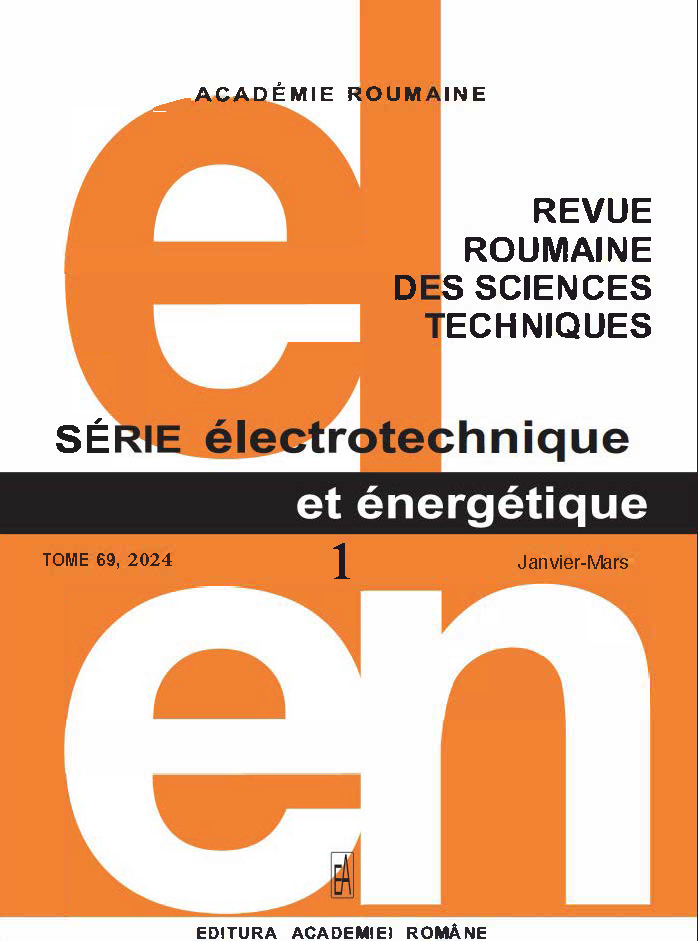TECHNIQUE DE CONTRÔLE INTÉGRÉE OPTIMISÉE POUR VAUTOUR AFRICAIN POUR APPLICATION DE POMPE À MOTEUR À INDUCTION À ENROULEMENT OUVERT À ALIMENTATION PV
DOI :
https://doi.org/10.59277/RRST-EE.2024.1.5Mots-clés :
Moteurs à induction à enroulement ouvert, Photovoltaïque, Impulsion couplée scalaire avec modulation (PWM), Optimisation du vautour africain, Double onduleur, Suivi du point de puissance maximale (MPPT), Distorsion harmonique totale (THD)Résumé
Les moteurs à induction à enroulement ouvert (OEWIM) ont retenu beaucoup d'attention et sont utilisés pour les applications de pompage alimentées par l'énergie solaire photovoltaïque (PV) comme alternative de compromis aux onduleurs à plusieurs niveaux. Les conditions d'irradiation solaire exacerbent encore le problème de contrôle non linéaire, entraînant une perte de puissance importante et une faible fiabilité, ce qui affecte le fonctionnement du moteur. Pour surmonter ces problèmes, cet article présente une technique de contrôle intégrée optimisée basée sur une technique de contrôle PV intégrée à trois niveaux à double onduleur alimentée par des moteurs à induction à enroulement ouvert pour les applications de pompage. Un algorithme intégré d'optimisation du vautour africain et des techniques de contrôle basées sur la modulation de largeur d'impulsion couplée scalaire (AVO-SCPWM) sont proposés pour extraire la puissance maximale de la source solaire photovoltaïque et contrôler la pompe à moteur à induction. Ici, la technique de suivi du point de puissance maximale (MPPT) basée sur AVO ajuste l'indice de modulation (ma) en fonction de l'ensoleillement et de la température. La technique proposée équilibre le courant homopolaire, réduit le THD et réduit les pertes de commutation sur l'onduleur. Le travail proposé est évalué dans le logiciel MATLAB/Simulink et comparé aux techniques de moteur à induction (IM) conventionnel existant, d'entraînement OEWIM conventionnel et aux techniques de IM basées sur PWM découplées scalaires dans deux conditions climatiques. Ainsi, les résultats de la simulation démontrent que la technique proposée est plus performante que les techniques existantes.
Références
(1) B. Mountain, P. Szuster, Solar, solar everywhere: opportunities and challenges for Australia’s rooftop PV systems, IEEE Power Energy Mag., 13, 4, pp. 53–60 (2015).
(2) A.A.A. Radwan, Y.A.R.I. Mohamed, Power synchronization control for grid-connected current-source inverter-based photovoltaic systems, IEEE Trans. Energy Conv., 31, 3, pp. 1023–1036 (2016).
(3) M.A. Elgendy, B. Zahawi, D.J. Atkinson, Operating characteristics of the P&O algorithm at high perturbation frequencies for standalone PV systems, IEEE Trans. Energy Conv., 30, 1, pp. 189–198 (2015).
(4) A. Costabeber, M. Carraro, M. Zigliotto, Convergence analysis and tuning of a sliding-mode ripple-correlation MPPT, IEEE Trans. Energy Conv., 30, 2, pp. 696–706 (2015).
(5) U.K. Kalla, N. Bhati, K. Chariya, I. Qureshi, I Design and analysis of solar PV fed IMD water-pumping system, In 2021 International Conference on Sustainable Energy and Future Electric Transportation (SEFET), IEEE, pp. 1–6 (2021).
(6) Y. Jiang, J.A.A. Qahouq, M. Orabi, Ac PV solar system distributed architecture with maximum power point tracking, Proc. IEEE International Telecommunications Energy Conference, IEEE-INTLEC'12, Scottsdale (AZ), USA (2012).
(7) S. Jain, A.K. Thopukara, R. Karampuri, V.T. Somasekhar, A single-stage photovoltaic system for a dual inverter-fed open-end winding induction motor drive for pumping applications, IEEE Trans. Power Electron., 30, 9, pp. 4809–4818 (2015).
(8) M.W. Shah, R.L. Biate, Design and simulation of Solar PV model using MATLAB/Simulink, International Journal of Scientific & Engineering Research, 7, 3, pp. 551–554 (2021).
(9) T. Ma, H. Yang, L. Lu, Solar photovoltaic system modeling and performance prediction, Renewable and Sustainable Energy Reviews, 36, pp. 304–315 (2014).
(10) S. Jain, A.K. Thopukara, R. Karampuri, V.T. Somasekhar, A single-stage photovoltaic system for a dual-inverter-fed open-end winding induction motor drive for pumping applications, IEEE Trans. on power Electronics, 30, 9, pp. 4809–4818 (2014).
(11) J. Korhonen, J. Honkanen, T.J. Kärkkäinen, J. Nerg, P. Silventoinen, Modulation and control methods to reduce zero sequence current in open-end winding motors, in 2017 IEEE International Electric Machines and Drives Conference (IEMDC), IEEE, pp. 1–6 (2017).
(12) G.A. Ghazi, H.M. Hasanien, E.A. Al-Ammar, R.A. Turky, W. Ko, S. Park, H.J. Choi, African vulture optimization algorithm-based pi controllers for performance enhancement of hybrid renewable-energy systems, Sustainability, 14,13, pp. 8172 (2022).
(13) A. Hossam-Eldin, H. Mostafa, H. Kotb, K.M. AboRas, A. Selim, S. Kamel, Improving the frequency response of hybrid microgrid under renewable sources’ uncertainties using a robust lfc-based African vulture optimization algorithm, Processes, 10, 11, pp. 2320 (2022).
(14) D. Benoudjit, S. Rid, N. Nait-Said, M. Saidnait-Said, L. Chrifi-Alaoui, Electric vehicle propelled by dual-induction motors structure: experimental results, Rev. Roum. Sci. Techn. – Électrotechn. Et Énerg., 68, 2, pp. 170–175 (2023).
(15) R. Sheeja, R. Nishant, Reduction in greenhouse gas emission by using sustainable transportation systems to increase the environmental and economic benefits, International Journal of System Design and Computing, vol. 01, 01, pp. 18–25 (2023).
(16) B. Sivasankari, M. Shunmugathammal, A. Appathurai, and M. Kavitha, High-throughput and power-efficient convolutional neural network using one-pass processing elements, Journal of Circuits, Systems and Computers, 31, 13, pp. 225–226 (2022).
(17) E.G. Boudissa, F. Habbi, M. Bounekhla, N. Dif, A memetic algorithm applied to induction machine parameters identification based on an output error: memetic algorithm for induction machine identification, Rev. Roum. Sci. Techn. – Électrotechn. Et Énerg.,68, 3, pp. 266–270 (2023).
(18) K.K. Kumar, M.W. Iruthayarajan, A.S. Kamaraja, Investigation of a solar incorporated improved quasi-Y-source dc–dc step-up converter connected with phase-shifted converter in electric vehicle battery charging, Electr. Eng., 105, pp. 3647–3667 (2023).
(19) P. Deepa, S. Rajakumar, P.J. Shermila, E.A. Devi, M.E. Prince, A.J.G. Malar, New hybrid Cuk-Landsman high gain dc-dc converter modelling and analysis, Power, 9, 8, pp. 8-16 (2022).
(20) A. Agasthian, R. Pamula, L.A. Kumaraswamidhas, Integration of monitoring and security based deep learning network for wind turbine system, International Journal of System Design and Computing, 01, 01, pp. 11-17 (2023).
(21) S.V. Lakshmi, M.A. Rejula, K. Sujatha, A. Ahilan, Recognition of brain stroke shape using multiscale morphological image processing, The Imaging Science Journal, 69, (1-4), pp. 28-37 (2021).
Téléchargements
Publiée
Numéro
Rubrique
Licence
(c) Copyright REVUE ROUMAINE DES SCIENCES TECHNIQUES — SÉRIE ÉLECTROTECHNIQUE ET ÉNERGÉTIQUE 2024

Ce travail est disponible sous licence Creative Commons Attribution - Pas d'Utilisation Commerciale - Pas de Modification 4.0 International.


